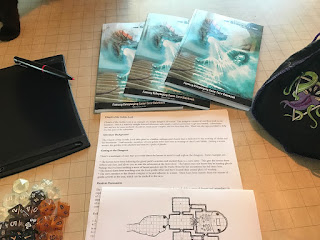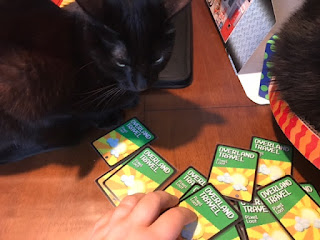I talked a bit about
magic in Heroes of the Sundered Chronicles last year, but I only briefly mentioned the concept of spell alignments. Basically, all spells belong to an alignment category that matches the character alignments: Law, Neutral, and Chaos. Mages gain access to Neutral spells and either Law or Chaos spells, which is chosen at character creation.
I originally had paladins with their own spell list, but as I got further into writing the magic chapter, it become pretty obvious that just giving paladins access to all of the Law spells was pretty close to what I was already giving them and was much, much simpler.
Why Spell Alignments?
Spell alignments are largely a design byproduct of removing divine magic from the game world. The gods are gone, so there’s no divine magic to be had. This meant the cleric went away as well (I never liked the cleric as a default divine spell caster anyway), but I wanted a lot of the spells that clerics have access to in S&W to still be available. My first draft combined the magic-user and cleric spell lists and gave access to all of it to the Mage, which was just flat out ugly.
I spent a lot time milling over ideas on how to limit the spells the Mage had access to without breaking it back out into two classes that would otherwise be very similar. Ultimately, I decided to split it into three groups – one universal and two that the player had to choose from. Associating them with the game’s 3 alignments was a perfect fit for both the mechanical tone of the categories and the lore of the game world.
Making the Spell Lists
Organizing the spells into the categories was mostly pretty easy. A lot of spells were just plain obvious as to where they belonged. I had decided on 6 spells of each alignment for each spell level, and I was determined. Some spells had to be cut, and I added new spells to fill in where there were gaps. There are also spells that I had to make hard decisions on where they went. The best example being Raise Dead.
I originally added Raise Dead to the Law alignment very quickly. I clearly wanted “good-guy” priests to be able to help PCs out with resurrections. But… raising someone from the dead clearly disrupts the natural order of things. A creature lives, it dies, and goes to the afterlife. It doesn’t come back. So, isn’t raising the dead much more a domain of Chaos?
I still see it belonging in both places. I think the solution is to introduce a new spell. Raise Dead stays as a Law spell, and can be used to coax powerful beings in the afterlife to allow the spirit of the target to return. Mages who have chosen Chaos spells can get access to a new spell, Dark Pact, which allows them to make bargains with the forces of Chaos to rip the soul out of the afterlife and revive the target.
Dark Pact
Spell Level: Chaos 5 (or Magic-User 5 for other OSR games)
Cast Time: 1 hour
Range: Special
Duration: Instantaneous
Much like Raise Dead, Dark Pact allows the caster to raise a corpse from the dead, provided it has not been dead for longer than 5 days. After finishing the casting of this spell, the caster communes with a powerful being of Chaos, such as a demon or powerful undead creature. In exchange for some kind of service or offering, the being rips the target’s soul from the afterlife and returns it to their body, bringing the target back to life. The target’s body must still be intact for this spell to succeed, though the body need not be present during the casting.
Which being is contacted, and what the creature asks for in exchange for bringing the target back to life is up to the Referee. Demons have been known to bargain for allegiances, favors, items of magical power, and for the caster’s soul. They’ve also been known to leave their mark on the body of the target, and sometimes the caster.
The
Heroes of the Sundered Chronicles Fantasy Roleplaying Game is currently in open playtest and is available as a
free download with no login or registration required.








